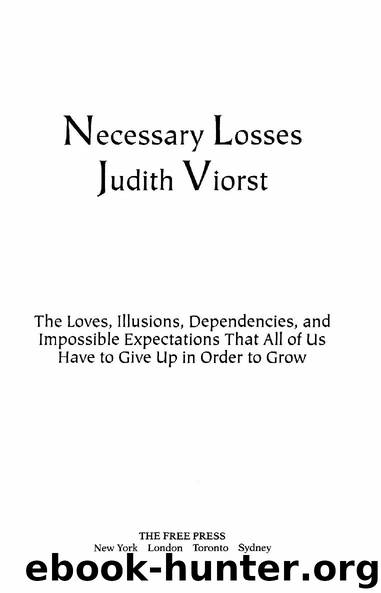Necessary Losses by Judith Viorst

Author:Judith Viorst
Language: eng
Format: epub
Publisher: Simon & Schuster
Published: 2010-05-11T00:00:00+00:00
17 Shifting Images
… I have found a mourning process for oneself as one gets older and must come to terms with change resulting from this unavoidable progression. One might describe this process as mourning for former states of the self, as if these states represented lost objects.
—Dr. George Pollock
We will mourn the loss of others. But we are also going to mourn the loss of our selves—of earlier definitions that our images of self depend upon. For the changes in our body redefine us. The events of our personal history redefine us. The ways that others perceive us redefine us. And at several points in our life we will have to relinquish a former self-image and move on.
The ages and phases of man—the tasks and character of successive stages of life—have been annotated by (and this surely does not exhaust the list) Confucius, Solon, the Talmud, Shakespeare, Erikson, Sheehy, Jaques, Gould and Levinson. The modern research suggests that there are normal predictable stages of adult development—though people go through them in drastically different ways. And it proposes that—in the general framework within which our separate destinies are worked out—periods of stability alternate with periods of transition.
In periods of stability, we are putting together a structure for our life—making key choices, pursuing certain goals. In periods of transition we are challenging the premises of that structure—raising questions, exploring new possibilities. Each transition leads to termination of a previous life structure, and each termination—writes the research psychologist Daniel Levinson—“is an ending, a process of separation or loss.” He goes on to say:
The task of a developmental transition is to terminate a time in one’s life; to accept the losses the termination entails; to review and evaluate the past; to decide which aspects of the past to keep and which to reject; and to consider one’s wishes and possibilities for the future. One is suspended between past and future, and struggling to overcome the gap that separates them. Much from the past must be given up—separated from, cut out of one’s life, rejected in anger, renounced in sadness or grief. And there is much that can be used as a basis for the future. Changes must be attempted in both self and world.
In the course of these changes we move from baby to kid to adolescent and then into the stages of adult life: Breaking away from the pre-adult world—the Early Adult Transition—between ages seventeen and twenty-two. Making, during our twenties, our first commitments to a job, a life-style, a marriage. Revising our selections in our late twenties and early thirties—the Age Thirty Transition—to add what is missing, to modify and exclude. Settling down and investing ourselves, during most of our thirties, in work, friends, family, community, whatever. And reaching, at about forty, those bridging years which take us from early to middle adulthood. Levinson calls this time the Mid-life Transition. For most of us it’s a crisis—a mid-life crisis. I have had one of my own:
What am I doing with a mid-life crisis?
This morning I was seventeen.
Download
This site does not store any files on its server. We only index and link to content provided by other sites. Please contact the content providers to delete copyright contents if any and email us, we'll remove relevant links or contents immediately.
Rewire Your Anxious Brain by Catherine M. Pittman(18553)
Talking to Strangers by Malcolm Gladwell(13222)
The Art of Thinking Clearly by Rolf Dobelli(10223)
Mindhunter: Inside the FBI's Elite Serial Crime Unit by John E. Douglas & Mark Olshaker(9201)
Becoming Supernatural by Dr. Joe Dispenza(8119)
Change Your Questions, Change Your Life by Marilee Adams(7635)
Nudge - Improving Decisions about Health, Wealth, and Happiness by Thaler Sunstein(7615)
The Road Less Traveled by M. Scott Peck(7522)
The Lost Art of Listening by Michael P. Nichols(7408)
Enlightenment Now: The Case for Reason, Science, Humanism, and Progress by Steven Pinker(7235)
Mastermind: How to Think Like Sherlock Holmes by Maria Konnikova(7227)
Win Bigly by Scott Adams(7094)
The Way of Zen by Alan W. Watts(6506)
Daring Greatly by Brene Brown(6446)
Big Magic: Creative Living Beyond Fear by Elizabeth Gilbert(5613)
Grit by Angela Duckworth(5523)
Ego Is the Enemy by Ryan Holiday(5294)
Men In Love by Nancy Friday(5156)
Altered Sensations by David Pantalony(5045)
